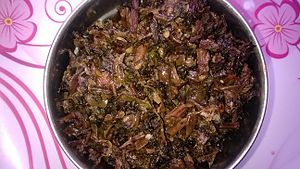
GUNDRUK GUNDRUK (PICKLED LEAFY VEGETABLE)
Gundruk[edit | edit source]
is particularly popular in Nepal. The annual production of
gundruk[edit | edit source]
in Nepal is estimated at 2,000 tons and most of the production is carried out at the household level.
Gundruk[edit | edit source]
is obtained from the fermentation of leafy vegetables in Nepal. It is served as a side dish with the main meal and is also used as an appetiser.
Gundruk[edit | edit source]
is an important source of minerals particularly during the off-season when the diet consists of mostly starchy tubers and maize which tend to be low in minerals
Raw material preparation[edit | edit source]
In the months of October and November, during the harvest of the first broad mustard, radish and cauliflower leaves, large quantities of leaves accumulate - much more than can be consumed fresh. These leaves are allowed to wilt for one or two days and then shredded with a knife or sickle.
Processing[edit | edit source]
The shredded leaves are tightly packed in an earthenware pot and warm water (at about 30
o[edit | edit source]
C) is added to cover all the leaves. The pot is then kept in a warm place. After five to seven days, a mild acidic taste indicates the end of fermentation and the
gundruk[edit | edit source]
is removed and sun-dried. This process is similar to sauerkraut production except that no salt is added to the shredded leaves before the start of
gundruk[edit | edit source]
fermentation. The ambient temperature at the time of fermentation is about 18
o[edit | edit source]
C.
Pediococcus[edit | edit source]
and
Lactobacillus[edit | edit source]
species are the predominant micro-organisms during
gundruk[edit | edit source]
fermentation. During fermentation, the pH drops slowly to a final value of 4.0 and the amount of acid (as lactic) increases to about 1% on the sixth day. It has been found that a disadvantage with the traditional process of
gundruk[edit | edit source]
fermentation is the loss of 90% of the carotenoids, probably during sun-drying. Improved methods of drying might reduce the vitamin loss
Flow diagram[edit | edit source]
Leafy vegetables
.[edit | edit source]
Wilt One to two days
.[edit | edit source]
Shred
.[edit | edit source]
Placed in earthen pot The leaves need to tightly packed
.[edit | edit source]
Cover the leaves Cover the leaves with warm water and straw
.[edit | edit source]
Ferment The pot is kept warm in the sun and by a fire by night.
.[edit | edit source]
Add warm water To keep the pot warm
.[edit | edit source]
Dried Product dried on mats in the sun